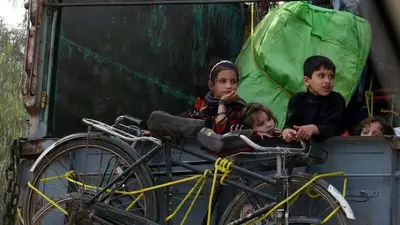World News
Rare glimpse inside neighborhood at the center of Haiti's gang war
PORT-AU-PRINCE, Haiti -- Cité Soleil is a Port-Au-Prince, Haiti, neighborhood of hundreds of thousands of people. It's one of the most desolate slums in the world and the center of a gang war between two powerful groups, G-9 and G-Pep. They're fighting for control over the area's large industrial complexes and access to one of the city's few major ports. The battle has lasted for the better part of two years.
The gang in control of this particular section of the neighborhood allowed ABC News in as long as no images were recorded passing into their territory. They did not want their enemies to learn anything about their defensive posture.
Still, lots of eyes were warily watching the ABC News convoy as it entered, joining a convoy led by the United Nations World Food Programme. The U.N. partners here with a local non-governmental organization (NGO) called Hands Together, bringing life-saving meals to the most vulnerable of populations—children.
This story is part of a series, "Haiti: The Forgotten Crisis." Please click here for more.

The school itself is a large open courtyard bordered on all sides by 12-foot-high concrete walls topped with barbed wire. A dozen or so classrooms are filled with kids separated by age, from five to 14 years old.
MORE: Video 'The Forgotten Crisis,' Part 1: Gang violence overwhelms Haiti amid political turmoil
Evens Brelhomme works with Hands Together and grew up in Cité Soleil and says the peace inside this school is very fragile.
"There's shootouts here sometimes," he told ABC News. "Sometimes the gangs will climb the walls and use the school as a base. Sometimes the police will do the same."
Case in point: Inside one of the classrooms, a section of crumbling concrete is actually collateral damage from a recent gang skirmish.
"This is where it hit," said Brelhomme, brushing the spot where a bullet smashed into the wall, a stray let loose during a firefight a few months back while the kids were inside. "It's terrifying. Sometimes you even find bullets in the yard."

ABC News spotted an unspent 9 mm round lying in the dirt minutes later. Told you, Brelhomme says.
It's about then a skinny kid in a school uniform tugs at Brelhomme's shirt. Michael Francois is a 12-year-old student, and he wants to talk.
"When I hear the shooting, I feel like I am nothing and I feel very weak. I go under my bed or try to close my ears to not hear it," he said.
ABC News received permission from his teacher and he led the way out the front gate of the school to his home right nearby. He showed ABC News the bed he hides under and introduced his mother. Shootings are just part of life, she said. But it's never been worse than this.
In the second half of 2022, the U.N. said more than 250 people were murdered in a section of Cité Soleil called Brooklyn, including 95 in just one horrific day. The U.N. also documented at least 57 gang rapes of women and girls.

The violence gets so bad that sometimes, this entire community is cut off from the outside world.
No food or water gets in and no trash gets out. Those horrific conditions led to a cholera outbreak last year, the first such event in Haiti since 2019. Dozens were killed, according to U.N. estimates. And it was in Cité Soleil that the WFP recently recorded famine-level conditions for tens of thousands of people, the most extreme classification on its hunger scale. That's never happened in Haiti before.
"I would like the shooting to stop so people can go out freely, be at home and have normal lives," said Michael.
Haiti's chaos has driven record levels of migration, with hundreds of thousands of Haitians leaving over the past several years.
Nearly 50,000 have taken advantage of a Biden administration humanitarian parole program, according to U.S. government data, and have been granted legal entry to the U.S. Others have made the treacherous voyage from South America up through the Colombia-Panamanian jungle, eventually arriving in Texas or Arizona or California.
Still others have taken what might be the most dangerous journey of them all, setting sail through the Caribbean after taking off from an island famous in its own right.

MORE: Carlee Russell searched movie 'Taken,' Amber Alerts before disappearance
Turtle Island, just off the coast of northern Haiti, has a History of smuggling and illicit activity that goes back hundreds of years. It was once a stronghold for buccaneers in the 16th and early 17th centuries.
The island has now become home to a nascent industry of human smuggling. More and more fishermen have become smugglers, using their knowledge of these waters to engage in a far more profitable endeavor.
Prices for human trafficking have skyrocketed as would-be migrants pay thousands of dollars each to book a spot on a sailboat usually headed for South Florida.
Several of these vessels are visible in a small inlet, dotted by two dozen or so boats. The bigger ones moor a few dozen meters offshore, passengers ferried to and from by a couple of teenage boys pushing row boats with long wooden poles.
At the end of a steep dirt road is a concrete hut used by many migrants over the years. This time, it was occupied by two women, Jeanette and Keisha, both in their mid-twenties, both waiting to Travel to the U.S.. They asked to be identified only by their first names, nervous about any reaction from U.S. immigration authorities.
"I had no other choice than to come to Turtle Island and try to leave," said Keisha.
This was not her first choice but back home in Port-au-Prince, she was constantly scared for her life. "I could see gang soldiers in front of my home every day," she said.
Once on Turtle Island, she met Jeanette, whose story is very similar. They're both from the capital, both victims of violence and terrified of going home. It's simply not an option anymore.
"I'm going to risk it because I'm already here," said Jeanette.
Both women are mothers of young children they're choosing to leave behind for now with relatives, trying to get to the U.S. to give them better lives. It's an expensive dream.
They've both said they've paid about $3,000 for the journey, their entire savings, a staggering sum in a country where the average annual household income is less than $1,500. Jeanette and Keisha have been on the island for a few weeks now, waiting for the boat to depart.
Back in the inlet, a moored sailboat with fading gray paint and a blue stripe along the side rocks gently in the light breeze.
The captain, who says his name is Jacqueline Aristide, is aboard. He's friendly, gracious even, showing off the boat he sails back and forth to the U.S.
It takes less than 10 seconds to walk aft to stern, about 20 feet long and bare bones. About 50 people can line the top deck but the true horrors lie beneath.
The cramped hull is lined with old sugar bags, now filled with sand and rock as ballast. There's next to no air flow, no windows and it's remarkably hot.
Aristide puts as many people down below as he does up top. The Business only works, he says, when he has as many people on board as possible.
It takes about five days to sail to the U.S. if all goes well. The U.S. Coast Guard has captured many such vessels in the last two years, often jammed with dozens and dozens of people.

Captains, crew and passengers are usually deported back to Haiti in days.
"Sometimes I reach the coast. Sometimes the [U.S. Coast Guard] catches us. Either way we just come back here and do it again," said Aristide.
For most migrants, it's their first time on board a boat for a long stretch.
Aristide crouches down next to the mast and picks up a weathered rope. This is what they use, he said, when people break down – when the heat and the ocean and the vast emptiness of it all gets to be too much.
"We lay them down and we tie them to the mast with this rope. Then we pour water over their head to calm them and ask them how they're feeling," he said. Absent such extreme measures, he said, they could be a threat to others on board.
"In all my years, no one has died on board," he said.
It's impossible to know how many have died taking this journey on this boat or the many others operating in these waters.
"Yes, I am afraid," said Jeanette. "There are people who travel in the boats and lose their lives. Sharks eat them. For some of them, it's the heat that kills them."
Aristide will only sail when he has a full boat and the numbers have slowed a bit as of late. More people have been trying to go the legal way, taking advantage of that Biden administration humanitarian parole program.
But everyone here expects the lull to be temporary. The numbers will pick back up again because Haiti's problems are myriad and their solutions are elusive.
The only guarantee is that more people will do whatever it takes to try and flee.
"I don't want to give up," said Jeanette. "I'm staying strong because it's my dream to go. I need to go."
-ABC News' Etant Dupain, Brandon Baur and Aicha El Hammar Castano contributed to this report.
-

 World News16h ago
World News16h agoMass Graves of Hundreds Uncovered in Gaza Sound Alarm
-

 World News16h ago
World News16h agoHow King Charles Will Mark His Return to Public-Facing Duties in a Meaningful Way
-

 World News23h ago
World News23h agoHead of Vietnam’s Parliament Resigns Amid Corruption Probe
-

 World News23h ago
World News23h agoA Japanese Town, Frustrated by Overtourism, Is Blocking Its Instagram-Famous View of Mt. Fuji
-

 World News1d ago
World News1d agoAt TIME100 Gala, Honorees Toast to the People and Causes That Matter to Them
-

 World News1d ago
World News1d agoTIME100 Honoree Motaz Azaiza Speaks on the Gaza Solidarity Encampments Taking Over U.S. Colleges
-

 World News1d ago
World News1d agoPhilippines Says ‘Foreign Actor’ Behind Deepfake of Marcos Urging Combat With China
-

 World News1d ago
World News1d agoSee the Stars of the 2024 TIME100 Gala in Scenes From the Gala

























